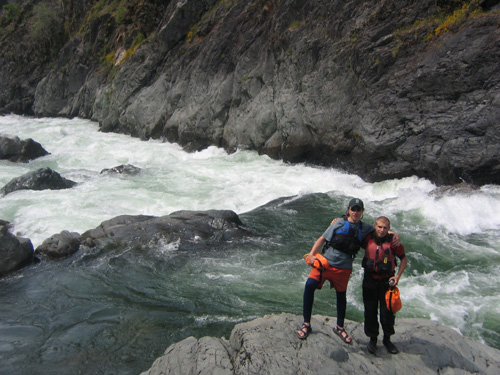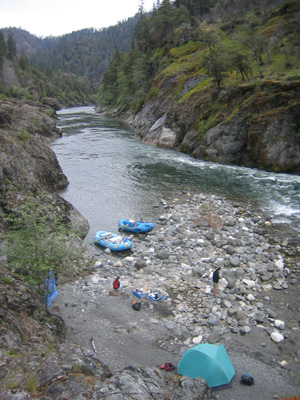This last weekend I took a raft down on the Illinois River, a gorgeous and remote river that flows into the Rogue west of Grants Pass. The run is 34 miles long and contains a lot of rapids, several of which are class IV and one that is class V. So let’s talk about that one, the big one. It’s called Green Wall and lies about 19 miles down river in the heart of the canyon. Many people break it up into two parts. At 2300 c.f.s, the first 150 yards are a big class IV boulder garden filled with big waves and holes. The river sweeps around a corner, slams into the wall on the right, and then the real action starts, as the whole river chugs through a constricted chute choked with boulders the size of houses, and creates many minor features mixed in with two distinct ledge drops.
So naturally, we have to scout this rapid. Of course, Will and I didn’t want to have to scramble along the river bank for a quarter mile just to get to the place where you can see the main part of the rapid, no, we’re lazy. We go with the popular plan of running the first half without scouting. There’s no pool in between the two drops, but there is a small eddy on the side of the river. We decide to run the class IV lead in, then catch this eddy and tie our boats up to scout. All was going well, we’re rowing through the lead-in, and all of a sudden, I realize I’m off my intended line, and dropping into a big hole. I have no choice but to run it, so I give a few hard oar strokes and crash into this stomping wave. It rocked me a bit, but I kept rowing and made it through the backwash.
But that’s only the beginning. Just below, I have to start making the ferry into the eddy. So I set up my angle and started making the pull into the eddy. It was looking fine, and then suddenly, my right oar popped completely out of the oar lock. Now being midstream in Green Wall at that water level with only one oar is significantly worse than being up shit’s creek without a paddle, because with only one oar all I can do is spin the boat in circles…..and I could see the scouting eddy slowly slipping away as the forceful current pulled me downstream toward a class V hydraulic that could not only flip my boat and send me swimming, but could completely tear my raft apart.
I quickly grabbed the oar that was momentarily useless and with both hands threw it back into the oarlock, setting myself up to row again. With a few hard pull strokes, I got my boat into the very bottom of the scouting eddy.
But the water I was in was still moving downstream and I wasn’t truly in the eddy. I kept pulling with all the strength I could find and rowed my loaded raft upstream against the moving current. I kept rowing until I had parked myself on a partially exposed boulder. The worst of it was over and my heart slowed down, but I had to keep rowing to stay in place until Will could pull over, tie off his boat, and come help me get back into the eddy.
So there we were, safe and sound, with our boats parked in the middle of a class V torrent of steep whitewater. We got out to scout the second and most difficult half of the rapid. Now, Green Wall is a drop I have studied through pictures, video, testimonials and personal experience for over a year now. I’d run it successfully three times before this last weekend, but of all the different water levels I’ve seen the rapid at, this was by far the nastiest.
Below the eddy where we had our boats parked, the river right wall was a sheer vertical cliff, offering no possibility of escape or rescue positioning. The river channel narrows significantly and the entire width of the river flows over a ledge that is followed by the boat-destroying hole I mentioned earlier. Fortunately, A small channel emerges just upstream of the drop on the river left side, but is still blocked off by a rock on the upstream end, you have to enter it from the side. So if you can kill all the momentum the river puts into your raft, you may be able to move sideways to the current enough to catch this narrow window and avoid the hole by going left.
You may now think that the challenge is over. You’re wrong. The left side of the initial drop is the place to be, but immediately downstream, the left two thirds of the river are a complex maze of boulders where you risk wrapping a raft around rocks. If you do end up there and are fortunate enough to avoid a serious wrap in there, that’s great, except there’s no way out. None of the channels exiting the left side boulder garden are wide enough at this water level to squeeze one tube of a raft through, much less the entire boat.
So after making that initial move left to avoid the thundering hole, you have to move back right all the way, again through screaming fast water, to avoid the inescapable room on the left. If you can manage to make that move back left, it’s pretty straightforward: just avoid wrapping on one last guard rock that you must go right of, straighten the boat out, and run the other half of the class V section where the river drops over another ledge with a rock on one side, a massive crashing wave on the other side, and the entire flow of the channel slamming into a the river right rock wall below. Then catch an eddy before the wave train ends or else you’re dropping into the steepest 3 miles of the river canyon while your buddy upstream has to run his boat through, counting on you to bail him out if he gets in trouble.
So now that I’ve introduced you to the rapid, let’s run it! By the time I was confident enough to get back into my boat, many other groups had arrived at the rapid and were scouting it. I had only watched one raft go through because they missed the pull into the scouting eddy. He got through safely, but the line was far from clean, as he ran numerous holes and pinballed backwards through some bony slots. With lots of people standing atop the monstrous boulders watching to see how I did, I buckled my helmet, untied my boat, and pushed off.
I stayed along the side of the channel, where the river wasn’t rushing as quickly, and tried to slow my speed as I approached the first terrifying hole. The window to move left was tighter than I expected, so while I made the move around the dangerous ledge, I was carrying much more speed than I wanted. I was starting to lose control. The bow of my boat bumped into a the wall and spun me against my will. I decided not to fight it and improvised. I angled my boat back to the right, drifted through a slot backwards, and started pulling. In the torrent of water flowing into the boulder-choked left side, I found two rocks that I could use to my advantage. I backed into the slack water behind them and slowed enough to make the pull back right, avoiding every exposed rock.
I took a breath and felt extreme relief as I made the toughest move. I looked downstream at the lower drop and for the first time in the entire rapid, I took a push stroke. I was no longer trying to slow down and play the avoidance game. It was time to row downstream and row hard. The water quickly sped my boat up and within seconds I had cleared the crashing waves and the wall. I caught the eddy below, tied my boat off, and scrambled ashore. I was sweating profusely, but that was the only moisture on my body. Green Wall soaked me that day, though my boat never took on water.
By Dan Thurber

